Do you want to make an app like Uber?
With the rise of online ride-hailing services as a whole and that of Uber has changed the taxi booking market forever.
Today, the industry is generating revenue like never seen before, and Uber – the taxi booking app leads it as the flag shipping, inspiring numberless other businesses and startups to build their own solution.
If you are inspired and want to create your own taxi booking app like Uber that will disrupt the market, you are right place.
This is a complete guide to create an app like Uber.
And we shall be discussing everything starting from the market overview, to how Uber works, to steps to develop an app, cost, monetization, and much more.
Therefore, with this being said, let’s get right into it, starting with:
Taxi Booking App Market Statistics
To understand the taxi booking market and its top player, Uber Statistics plays a vital role.
Let’s look at some of the important statistical data surrounding the industry and the reasons why so many people businesses & investors are interested in them:
- Global market size: $283 billion by 2028, with a CAGR of 4.2% (2023-2028). Currently, the revenue is estimated to be $133 billion in 2024.
- Over 300 million users worldwide, with DiDi and Uber holding around 150 million.
- Market Leaders are DiDi with Top revenue (approx. $19.7 billion in 2023), followed by Uber, Second in revenue ($14 billion in 2023).
This clearly shows just how much money there is to be made in the market. And with this said, it’s time to look the market leader, Uber.
Uber Overview: Rise of Taxi Booking App
Uber is a well-known name in the taxi booking industry. Rather, it won’t be incorrect to say, it’s the face of the industry.
Let’s see where the idea comes from.
Imagine New Year’s Eve in Paris, struggling to find a cab in the snow.
That’s the scenario that sparked Uber’s creation in 2009. Co-founder Garrett Camp, frustrated by his experience, teamed up with Travis Kalanick to build a better way to hail a ride.
The service was first launched in 2010 in San Francisco as “UberCab”, offering luxury black car service via a smartphone app leveraging on-demand app development.
It was a hit with tech-savvy urbanites but faced resistance from traditional taxi operators.
| Founded | 2009, San Francisco |
| Mission | Make transportation as reliable as running water |
| Key innovations | Smartphone app, upfront pricing, various car classes, delivery services |
| Challenges | Driver issues, safety concerns, regulations |
| Future | Sustainability, self-driving cars, shaping urban mobility |
| Availability | iOS and Android |
However, by overcoming the resistance and with a focus on convenience and transparency, Uber won over users.
They introduced cheaper car classes like UberX, expanding their reach. Social media and word-of-mouth fueled rapid growth, making Uber a household name.
Fast forward to today, Uber operates in over 10,000 cities worldwide, facing competition from rival ride-hailing platforms and exploring new transportation solutions.
In no time, you can also see the Uber RoboTaxi app. Showing how the company is committed to sustainability and developing self-driving technology, aiming to shape the future of mobility.
But what exactly does inspire so many people to make an app like Uber? Well, we have to say that’s the revenue.
| Metrics | Q3 2023 | YoY Change |
| 1. Gross Bookings | $15.7 billion | +72% |
| 2. Revenue | $8.3 billion | +61% |
| 3. Adjusted EBITDA | $665 million | +23% |
| 4. Monthly Active Platforms (MAPs) | 122 million | +19% |
| 5. Trips Completed | 1.8 billion | +38% |
Uber Services and Types of Rides
- UberX– cost-efficient option
- UberSELECT– high-end service compared with UberX
- UberBlack– premium ride for up to 4 persons
- UberXL– cost-efficient option for a group of 6 persons
- UberSuv– luxury option compared to UberXL
- UberLux– the most luxurious Uber transportation service
- UberPool– the ride-sharing app to splits the ride cost with other travelers
- UberASSIST & WAV– a car service developed for people with limited physical mobility
Moving on, now that you know the basic overview of Uber, it’s time to look at how it works, an important step in learning how to build an app like Uber.
How Does Uber App Work?
Before you try and create an app like Uber, it’s essential to understand how the platform works.
While it seems like a simple enough concept, creating a streamlined and unified workflow is very important.
That’s why we take inspiration from the best in the market.
And to make it easier to understand, we have divided the Uber app workflow into smaller and more understandable steps.
Let’s look at them below:
How Does Uber App Work for Riders?
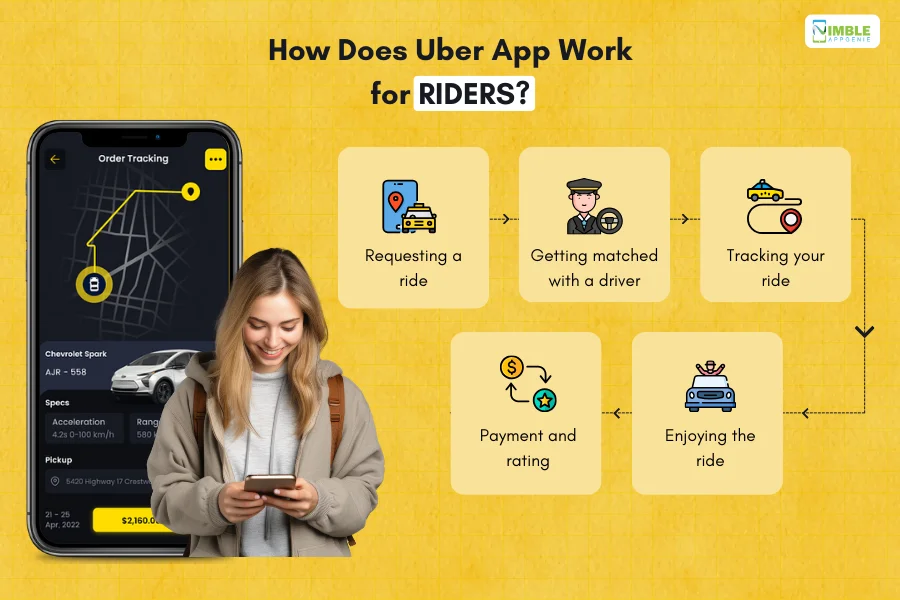
1. Requesting a ride
- Open the Uber app and enter your destination in the “Where to?” section. You can also set your pickup location or let the app automatically detect it.
- Choose your preferred vehicle type from available options like UberX, UberPool, UberBlack, etc., each offering varying levels of comfort and capacity.
- Fares are usually shown upfront before confirming the booking, so you know exactly how much you’ll pay.
- Once confirmed, the app starts searching for nearby drivers.
2. Getting matched with a driver
- The app uses an algorithm to match you with the closest available driver based on your location, vehicle preference, and other factors.
- You’ll see the driver’s photo, car model, license plate number, and estimated arrival time on the app screen.
3. Tracking your ride
- You can track your driver’s real-time location on the map within the app.
- You can also contact the driver directly through the app if needed.
4. Enjoying the ride
- Relax and enjoy the ride to your destination.
- You can play music, control the air conditioning, or chat with your driver (if they’re open to it).
5. Payment and rating
- Once you reach your destination, the fare is automatically charged to your chosen payment method (linked to your Uber account).
- You can then rate your driver and provide feedback on your experience to help Uber improve its services.
How Does Uber App Work for Drivers?
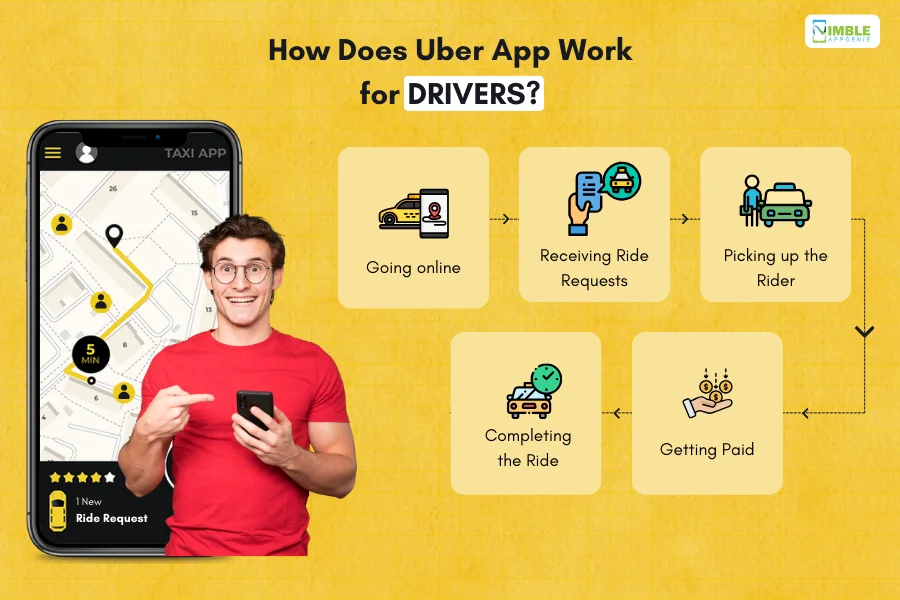
1. Going online
- Drivers open the Uber driver app and switch themselves “online” to indicate they’re available for rides.
- They can set their preferred area of operation and choose which vehicle types they’re willing to accept requests for.
2. Receiving ride requests
- When a rider requests a trip near a driver’s location, the driver gets a notification on their app.
- They can see the rider’s pickup location, destination, estimated fare, and vehicle type requested.
- Drivers can choose to accept or reject ride requests based on their preference and availability.
3. Picking up the rider
- Once a driver accepts a ride request, they’ll receive turn-by-turn navigation to the rider’s pickup location within the app.
- Upon arrival, the driver confirms the rider’s identity and begins the trip.
4. Completing the ride
- Drivers follow the in-app navigation to the rider’s destination.
- Once the rider reaches their destination, the driver ends the trip.
5. Getting paid
- The fare is automatically deducted from the rider’s payment method and deposited into the driver’s account after the trip.
- Drivers can track their earnings and view their trip history within the app.
Now that we are done with how Uber works for both rider and driver, let’s move to the next section and look at other popular apps like Uber.
Other Popular Taxi Booking Apps Like Uber
In this section of the guide to creating an Uber-like app, it’s time to look at the taxi booking app’s alternative.
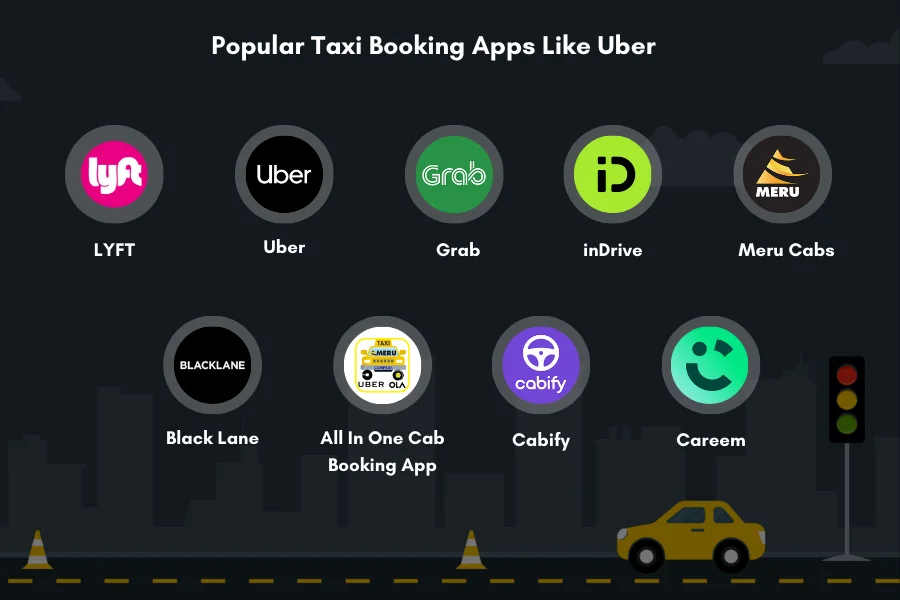
So, let’s look at top taxi booking apps that you should take inspiration from. These are, as mentioned below:
1. Lyft
Let’s start with Uber’s closest competitor, known for its vibrant pink branding and shared rides.
We are talking about, LYFT.
The taxi booking app is strong in the US and Canada. And the platform often touts driver and passenger benefits, like shared earnings tips and community initiatives.
Being one of the market leaders, there are many who want to build an app like LYFT.
2. Cabify
If you want to develop an app like Uber for the Latin world, you better take inspiration from Cabify.
Known for its strong presence in Latin America and Spain, this app offers a user-friendly interface and rewards programs for both riders and drivers.
3. Grab
If you want to build an app like grab taxi, you wouldn’t be the only one.
Southeast Asia’s ride-hailing giant, offering not just cars but motorbikes, taxis, and even food delivery.
Grab’s super-app approach integrates multiple services for seamless convenience.
4. Blacklane
Luxury ground transportation or taxi services have grown very popular recently.
Here we have the global leader in luxury ground transportation, offering chauffeur-driven sedans and SUVs.
Blacklane caters to a high-end clientele with personalized service and airport meet-and-greet options.
5. inDrive
Let’s talk about one of the most popular ridesharing apps, inDrive.
The “pay-what-you-want” ridesharing app, where riders set their price and negotiate directly with drivers.
And it’s quite popular for budget-conscious travelers and in areas with less price regulation.
6. Careem
Moving to the MENA reason, we have the market leader Carrem.
Domination the market of Middle East and North Africa powerhouse, it is popular for its diverse services, including bikes, carpooling, and even grocery delivery.
Much like Uber itself, this platform is totally focused on convenience with local integration as cherry on top.
7. Bolt
Don’t recognize the Bolt?
Well, it was formerly known as Taxify.
Bolt is a European budget ride-hailing app known for its low fares and fast service.
Popular in Eastern Europe and Africa, Bolt is expanding rapidly. And that’s one of the reasons why so many people want to build bolt like app.
8. BlaBlaCar
Yet another example of a ride-sharing market leader is the BlaBlaCar app.
As it turns out, people don’t only want to create an app similar to Uber but there are a lot of companies planning to build a BlaBlaCar-like app.
Well, you can’t go wrong with this one.
Now that we are the top taxi booking for inspiration to create your own taxi booking app, it’s time to move to the next section.
Here, we shall be looking at the features that you should include in your Uber-like app.
Features You Should Include In Your App Like Uber
It’s time to look at the feature.
Whether you want to know how to create an Uber clone app or a unique taxi booking app, the feature plays an important role in the success of the platform.
So, if you want your app to attract the target audience, it’s important to choose the right one. To help you with that, we shall be looking at the basic features to include in your Uber-like solution.
A] Passenger Panel
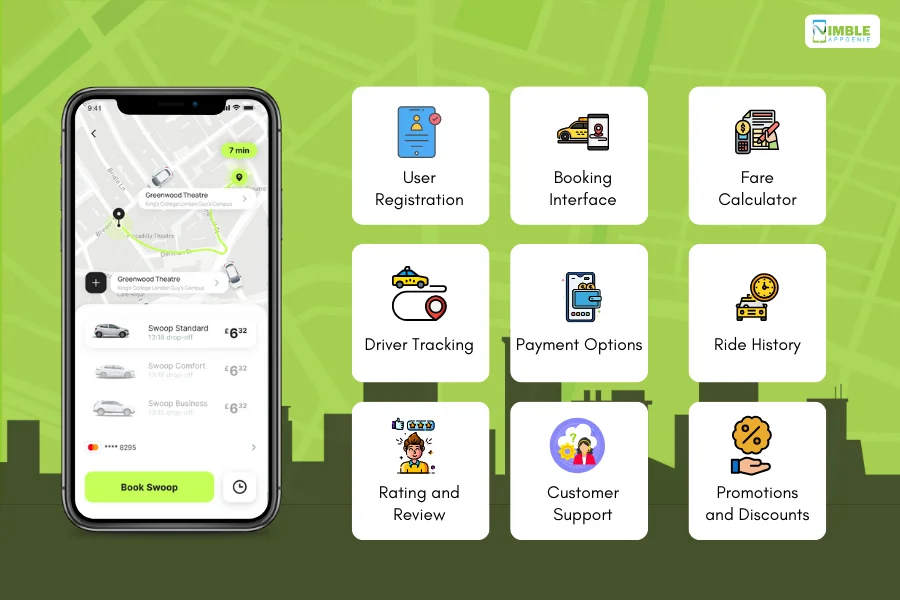
- User Registration/Login: Secure registration and login options for users to access the app, possibly including social media integrations for convenience.
- Booking Interface: A user-friendly interface for entering travel details, such as pickup and drop-off locations, and booking rides.
- Fare Calculator: An upfront fare estimation feature based on distance, traffic, and surge pricing, if applicable.
- Driver Tracking: Real-time tracking of the driver’s location once the ride is booked, enhancing safety and providing ETA updates.
- Payment Options: Multiple payment methods, including credit/debit cards, mobile wallets, and in some regions, cash payments.
- Ride History: A detailed history of past rides, including dates, routes, fare breakdowns, and driver details.
- Rating and Review System: An option for passengers to rate their ride experience and provide feedback about the driver and vehicle.
- Customer Support: Access to help and support features within the app for dealing with issues, questions, or emergencies.
- Promotions and Discounts: Access to promotional offers, discounts, and loyalty programs to encourage frequent use.
B] Driver Panel
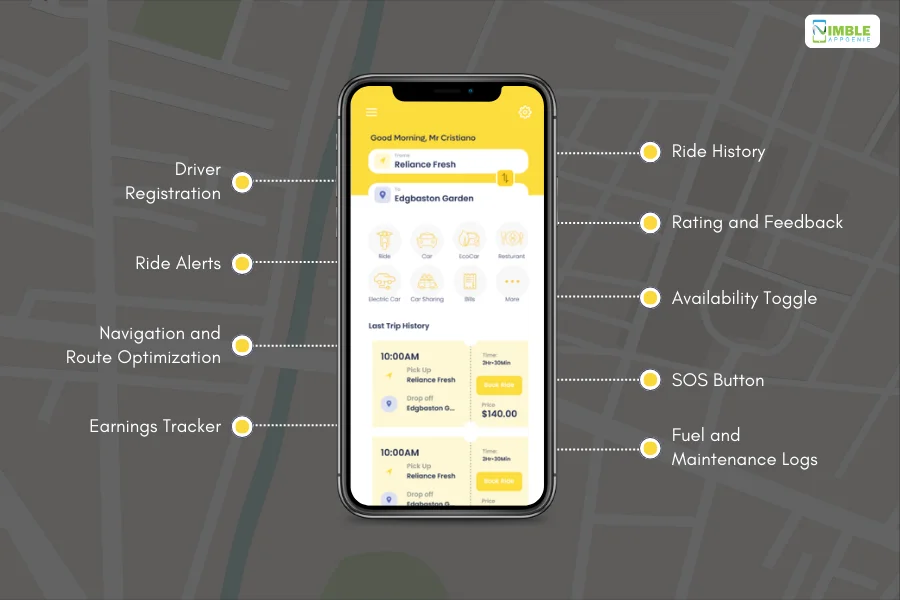
- Driver Registration/Profile: A thorough registration process for drivers to create profiles, which might include submitting documents and passing background checks.
- Ride Alerts: Notifications about new ride requests, including details like location and fare estimates, allowing drivers to accept or decline.
- Navigation and Route Optimization: Integrated navigation features and route optimization to assist with finding the best routes to the passenger and destination.
- Earnings Tracker: A feature to track earnings in real-time, including the ability to view daily, weekly, or monthly earnings.
- Ride History: Detailed logs of completed, canceled, and upcoming rides, including timestamps, earnings per ride, and passenger feedback.
- Rating and Feedback: Access to passenger ratings and feedback to help drivers improve their service and address any recurring issues.
- Availability Toggle: An option for drivers to toggle their availability status, allowing them to choose when they want to accept rides.
- SOS Button/Emergency Contacts: An in-app emergency button for drivers to alert local authorities or predefined contacts in case of emergencies.
- Fuel and Maintenance Logs: Features to track fuel expenses and vehicle maintenance history, helping drivers manage their operational costs effectively.
C] Admin Panel
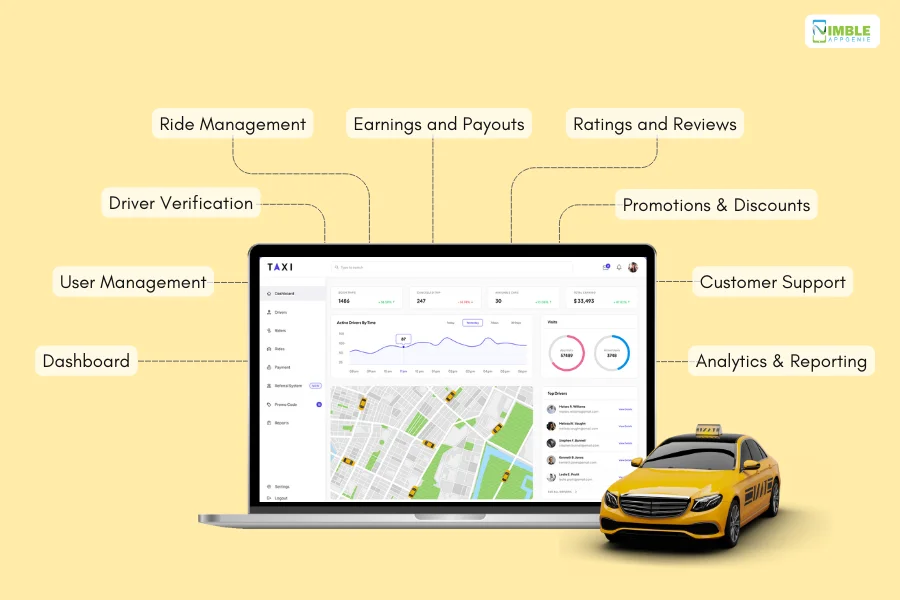
- Dashboard: A comprehensive overview of real-time app statistics, including active rides, number of users/drivers online, total earnings, and more to monitor the app’s performance at a glance.
- User Management: Tools to view, manage, and edit user profiles, including passengers and drivers, with the ability to add, remove, or suspend accounts as needed for security or compliance reasons.
- Driver Verification: A system to manage and verify driver documents, background checks, and vehicle information to ensure safety and compliance with local regulations.
- Ride Management: Capabilities to view and manage ongoing, completed, and scheduled rides, with detailed information on routes, users involved, and transaction details.
- Earnings and Payouts: Financial management tools to oversee earnings, process driver payouts, manage commission rates, and handle billing and invoicing.
- Ratings and Reviews: A module to monitor and manage user and driver ratings and reviews, allowing the admin to address negative feedback and reward positive service.
- Promotions and Discounts: Tools to create, manage, and analyze promotional campaigns and discount offers to increase user engagement and loyalty.
- Customer Support: A centralized system for handling user and driver queries, complaints, and feedback, including ticketing systems and support analytics.
- Analytics and Reporting: Advanced analytics tools to generate detailed reports on app usage, financials, service quality, and other key performance indicators to aid in strategic decision-making.
Now that we are done with the basic features, it’s time to look at the advanced ones. Let’s get into it.
Advanced Features to Consider When You Build a Taxi Booking App
Taking it a step further and to help your solution for taxi booking be unique, here are some advanced features to include in clone app development.
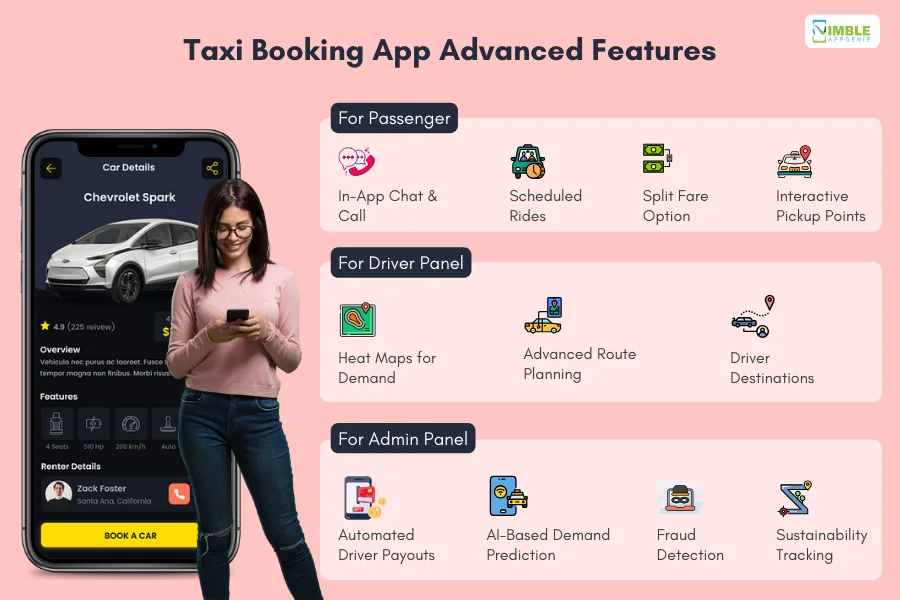
Let’s look at them below.
A] Advanced Features for Passenger Panel
- In-App Chat & Call
We have all used chat apps, right? Well, just like that, this feature allows passengers and drivers to communicate directly within the app without sharing personal contact details, ensuring privacy and security.
- Interactive Pickup Points
With augmented reality development or enhanced map features, you can help passengers pinpoint their exact pickup locations, improving driver-passenger coordination.
- Scheduled Rides
If you want to make an app like Uber for added comfort, you can use this feature et enable passengers to book rides in advance, choosing a specific date and time for future travel convenience.
- Split Fare Option
Powered by Payment Gateway Integration in the Taxi app, we can get features like Split fare. This facilitates passengers to share ride costs with friends or co-passengers directly through the app, simplifying payments and encouraging ride-sharing.
B] Advanced Features for Driver Panel
- Heat Maps for Demand
In the drive panel, this feature provides them with real-time heat maps showing areas of high demand, helping them position themselves in locations where they are more likely to get ride requests.
- Advanced Route Planning
Powered by geofencing and sophisticated route planning tools, driven panels get features like real-time traffic, road closures, and weather conditions to optimize travel time and fuel efficiency.
- Driver Destinations
This feature allows drivers to set preferred destinations, enabling them to receive ride requests that align with their intended route, maximizing their earning potential while on personal journeys.
C] Advanced Features for Admin Panel
- Automated Driver Payouts
Finally, at the admin panel, you may implement an automated system for calculating and processing driver earnings and payouts, reducing administrative workload and ensuring timely payments.
- AI-Based Demand Prediction
Use artificial intelligence in the app to analyze historical data and predict demand surges, enabling more efficient driver allocation and pricing adjustments.
- Fraud Detection
Using advanced algorithms and machine learning, this feature can detect and prevent fraudulent activities, protecting both users and drivers from scams and unauthorized transactions.
- Sustainability Tracking
You may also offer features to track and report on the environmental impact of rides, including carbon footprint calculations, and promote eco-friendly options like electric or hybrid vehicles.
So, these are the advanced features to consider when you want to make an app like Uber. And not, it’s time to look at not how to create an app similar to Uber, but why.
Why Build a Taxi Booking App Like Uber?
Well, there are many who would tell you how to make an app like Uber from scratch, but there’s yet another important question, why invest in app development?
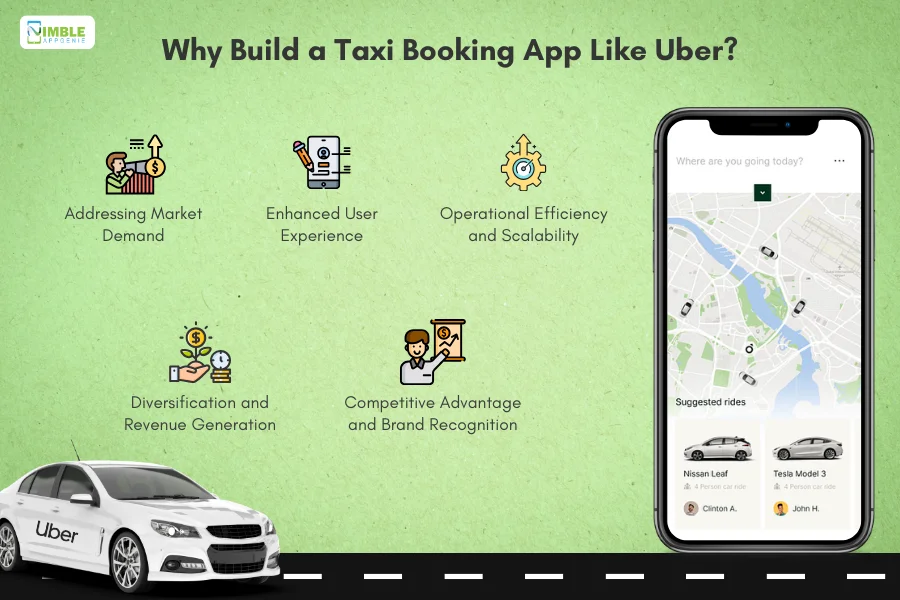
After all, with the high cost, time, and effort involved, going for Uber app development can be a rather big project.
1. Addressing Market Demand
The rise of the gig economy and the shift towards digital platforms have significantly increased the demand for convenient transportation services.
A taxi booking solution as one of the gig apps caters to this need by providing a reliable, efficient, and user-friendly solution for urban mobility. By analyzing market trends and user preferences, businesses can tailor their services to meet the evolving needs of their target audience.
Thus, ensuring high engagement and customer satisfaction.
2. Enhanced User Experience
Developing a taxi booking app allows businesses to offer a seamless user experience, from easy booking and real-time tracking to secure payment options and feedback mechanisms.
By leveraging technology such as GPS, AI, and data analytics, businesses can enhance operational efficiency, minimize wait times, and personalize services, fostering customer loyalty and repeat business.
3. Operational Efficiency and Scalability
An app like Uber streamlines operations by automating tasks such as dispatching, scheduling, and payments, reducing overhead costs and human error.
This efficiency not only improves service delivery but also provides a scalable business model that can adapt to different markets and customer segments, enabling expansion and growth.
4. Diversification and Revenue Generation
A taxi booking app offers multiple revenue streams, including ride fares, surge pricing, subscription models, in-app advertising, and partnerships.
In addition to this, businesses can diversify their services to include carpooling, food delivery, and freight services, further increasing revenue potential and market reach.
5. Competitive Advantage and Brand Recognition
In a crowded market, a well-designed taxi booking app can serve as a key differentiator, offering unique features, superior service quality, and a strong brand identity.
By prioritizing user safety, privacy, and satisfaction, businesses can build a loyal customer base and enhance their reputation, positioning themselves as leaders in the transportation sector.
Now that we are done with the reason why you should build a taxi booking app, it’s time to look at more technical side of things.
Taxi App Architecture for App Like Uber
While this is a more technical part of the Uber-like app development guide, it’s quite important.
Mobile app architecture plays an important role, especially when you are creating a complex app like Uber. Let’s look at the basic overview in the table below.
| Components | Description | Technology Stack | Communication |
| 1. Passenger App | User interface for ride booking, tracking, payment, and reviews. |
|
|
| 2. Driver App | Drivers receive ride requests, navigates, manages rides, and earn fares. |
|
|
| 3. Admin Panel | Manage drivers, vehicles, fares, and promotions, and analyze data. |
|
|
| 4. Backend | Server-side logic, APIs, database management, real-time communication. |
|
|
App Architecture vs App Tech Stack
Think of it this way: app architecture is the blueprint of your house, defining how rooms connect and function, while the app tech stack is the bricks and mortar, the specific tools and materials used to build it. One determines the layout and flow, the other the concrete elements that bring it to life. Both are crucial for a solid, well-functioning app!
Taxi Booking App Development Process
At this point in this cab booking app development guide, we have gone through a lot of important regarding the topic. And it’s time to look at the
It’s time to look at the step-by-step process to make an app like Uber.
In this section, we shall be looking at the entire app development process, defining each one in detail.
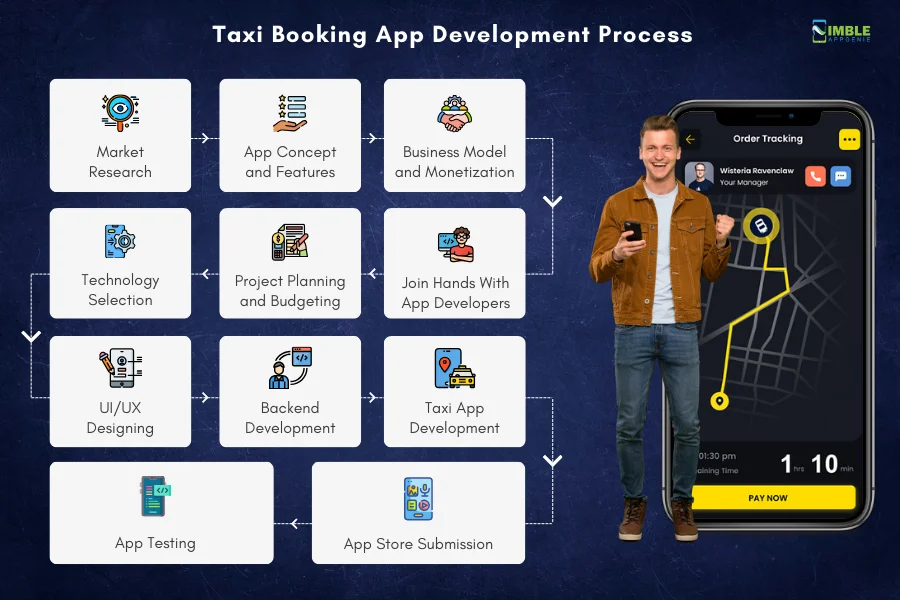
So let’s get right into it:
Step 1: Market Research
The process to make an app like Uber starts with app market research.
Taxi booking app is huge, that’s why, we begin with thorough market research to understand the dynamics of the taxi booking industry.
Here, we analyze competitors, identify target demographics, and understand user needs and preferences.
This foundational step informs your app’s unique value proposition.
Thus, ensuring it meets market demands and stands out in the crowded ride-sharing and taxi app market.
In simple words, information gathered via research works as fuel for developing a taxi application.
Step 2: App Concept and Features
With the research done, it’s time to define your app’s concept by focusing on innovative features that enhance the taxi booking experience.
Essential features might include real-time tracking, easy payment options, ride history, driver and passenger ratings, and in-app communication, as we have already discussed above.
Here’s more details on them including the cost and time involved.
| Panels | Features | Estimated Development Time (Hours) | Estimated Cost Range (USD) |
| 1. Passenger Panel | User Registration/Login | 40-60 | $2,000 – $4,500 |
| Booking Interface | 60-100 | $3,000 – $7,500 | |
| Fare Calculator | 30-50 | $1,500 – $3,750 | |
| Driver Tracking | 50-70 | $2,500 – $5,250 | |
| Payment Options | 70-90 | $3,500 – $6,750 | |
| Ride History | 40-60 | $2,000 – $4,500 | |
| Rating and Review System | 30-50 | $1,500 – $3,750 | |
| Customer Support | 40-60 | $2,000 – $4,500 | |
| Promotions and Discounts | 50-70 | $2,500 – $5,250 | |
| 2. Driver Panel | Driver Registration/Profile | 60-80 | $3,000 – $6,000 |
| Ride Alerts | 40-60 | $2,000 – $4,500 | |
| Navigation & Route Optimization | 70-90 | $3,500 – $6,750 | |
| Earnings Tracker | 50-70 | $2,500 – $5,250 | |
| Ride History | 40-60 | $2,000 – $4,500 | |
| Rating and Feedback | 30-50 | $1,500 – $3,750 | |
| Availability Toggle | 20-40 | $1,000 – $3,000 | |
| SOS Button/Emergency Contacts | 30-50 | $1,500 – $3,750 | |
| Fuel and Maintenance Logs | 40-60 | $2,000 – $4,500 | |
| 3. Admin Panel | Dashboard | 70-90 | $3,500 – $6,750 |
| User Management | 60-80 | $3,000 – $6,000 | |
| Driver Verification | 50-70 | $2,500 – $5,250 | |
| Ride Management | 60-80 | $3,000 – $6,000 | |
| Earnings and Payouts | 70-90 | $3,500 – $6,750 | |
| Ratings and Reviews | 40-60 | $2,000 – $4,500 | |
| Promotions and Discounts | 50-70 | $2,500 – $5,250 | |
| Customer Support | 60-80 | $3,000 – $6,000 | |
| Analytics and Reporting | 80-100 | $4,000 – $7,500 |
Apart from this basic feature, it’s also important to consider advanced options like ride-sharing, fare estimates, and loyalty programs to further enrich the user experience and engagement.
In any case, once we are done with all of that, it’s time to deal with taxi booking app business model.
Step 3: Taxi App Business Model
Want to make money with your taxi app? Well, that’s the main reason why people create a taxi booking app in the first place.
For this, you need to develop a clear business model outlining how your taxi booking app will generate revenue. These are also known as app monetization strategies.
Some of the common strategies include charging drivers a commission per ride, surge pricing during high demand, subscription apps, and in-app advertising.
| Business Model | Description | Monetization Strategy |
| 1. Commission-Based | The app owner charges drivers a commission for each ride completed through the platform. This is the most common model used by companies like Uber and Lyft. |
|
| 2. Subscription-Based | Drivers pay a recurring fee to access the platform and receive ride requests. This can be in addition to or instead of commission fees. |
|
| 3. Ride Fare Surcharge | A small surcharge is added to the customer’s fare, which goes directly to the app owner. This can be a fixed amount or a percentage of the total fare. |
|
| 4. Premium or Featured Listings | Drivers or taxi companies pay to have their services featured more prominently within the app, increasing their visibility to potential passengers. |
|
| 5. In-App Advertising | Displaying advertisements within the app. This can include banner ads, full-screen ads, or sponsored content. Partnerships with local businesses can also be formed for mutual promotion. |
|
| 6. Cancellation Fees | Charging passengers a fee if they cancel the ride after a certain time frame. This fee can be shared between the driver and the app owner to compensate for the driver’s time and effort. |
|
| 7. Dynamic Pricing or Surge Pricing | Prices increase during high-demand periods, such as rush hours, bad weather, or special events, to encourage more drivers to be available. |
|
| 8. Corporate Partnerships | Collaborating with businesses to provide transportation for their employees, guests, or clients. This can be structured as an account-based system where the business is billed monthly for the services used. |
|
| 9. Value-Added Services | Offering additional services such as in-car Wi-Fi, luxury car options, child seats, or accessibility features for an extra fee. |
|
| 10. Data Monetization | Selling or leveraging the vast amounts of data generated by the app (with proper anonymization and privacy measures) for insights into traffic patterns, urban planning, or targeted advertising. |
|
| 11. Cross-Promotion Deals | Partnering with other service providers (e.g., hotels, restaurants, event organizers) to offer discounts or special deals to app users. This can drive usage of the app and provide an additional revenue stream through these partnerships. |
|
Done? Let’s join taxi app developers.
Step 4: Join Hands With App Developers
It’s time to find an app developer who will turn your idea into reality.
It goes without saying it is important to collaborate with experienced app developers who specialize in taxi app development.
Here, we need to look for a team with a proven track record in ride-sharing apps, as they can offer valuable insights and innovative solutions. This is a crucial step in understanding how to create a taxi booking app.
Their expertise in the latest technologies and trends in the taxi booking app market will be crucial for creating a competitive and user-friendly app.
Now, there are a few options to find developers. These include:
- Outsource to a development company
- Staff Augmentation
- Or assemble an in-house team
Actually, there has been quite a day for in-house vs outsource.
Now, both of them have their own benefits and challenges. At the end of the day, it’s your choice and business needs that matter.
With that said, it’s time to start project planning.
Step 5: Project Planning and Budgeting
In this step, we estimate app development costs, timeline, resources, and potential risks.
But how?
Well, along with the developer, businesses create a detailed project plan that outlines each development phase, milestones, timelines, and budget.
It goes without saying effective planning and budgeting are crucial for managing resources efficiently and ensuring the project stays on track.
But it’s also important to consider potential challenges and include contingency plans to mitigate risks.
Step 6: Technology Selection
It’s time to choose appropriate technologies for the backend (e.g., Node.js, Python), mobile platforms (e.g., native, cross-platform), databases, APIs, and payment gateways.
What we need to do here is decide between native development (iOS/Android) for the best performance or cross-platform development for broader reach and cost efficiency.
Technologies like cloud services, GPS, and payment gateways should be chosen for scalability, reliability, and security.
Speaking of which, let’s get right into it, starting with the first.
A] Choose Development Platform
Mobile app platform refers to the technologies on which apps are built and meant to be run on. Now, there are two types of hybrid and native app development.
Moving down native gives us two options.
- Hire iOS app developers to build an iOS taxi booking application.
- Or you can go with Android app development.
Choosing the right one is important. But what’s more important is selecting the right tech stack.
B] Select or Build a Tech Stack
Now that we are done with the platform, it’s time to look at the mobile app tech stack.
Here’s an example of the technologies used to build a taxi booking app.
| Components | Technology/Tool | Description |
| 1. Server Side | Backend | Node.js / Express.js: For building scalable server-side applications and RESTful APIs. |
| Database | MongoDB / PostgreSQL: MongoDB for a flexible, JSON-like document store; PostgreSQL for relational data. | |
| Real-Time Engine | Socket.IO: Enables real-time, bidirectional, and event-based communication. | |
| Authentication | JWT (JSON Web Tokens): Securely transmits information between parties as a JSON object. | |
| Cloud Services | AWS / Google Cloud: For computing, database, storage, and other cloud services. | |
| 2. Client Side (iOS) | Language | Swift: Modern programming language for iOS development. |
| Framework | UIKit / SwiftUI: For building graphical user interfaces in iOS applications. | |
| Map Services | MapKit: For embedding maps and location services into iOS apps. | |
| 3. Client Side (Android) | Language | Kotlin / Java: Kotlin is a modern, concise language; Java is traditional and widely used. |
| Framework | Android SDK: Software development kit for Android apps. | |
| Map Services | Google Maps API: For integrating maps and location services into Android apps. | |
| 4. Testing & Deployment | Unit Testing | JUnit / XCTest: JUnit for Java (Android); XCTest for Swift (iOS). |
| UI Testing | Espresso / XCUITest: Espresso for Android UI testing; XCUITest for iOS UI testing. | |
| CI/CD | Jenkins / GitLab CI: Automation servers for continuous integration and deployment. | |
| Containerization | Docker: For creating, deploying, and running applications in containers. | |
| Orchestration | Kubernetes: Automates deployment, scaling, and management of containerized applications. |
Once, done with this, it’s time for API.
C] API Integration Option for Taxi App
APIs make the cab booking app development process much easier. And we shall be going through some of the best ones. These are, as mentioned below:
| Functionality | API Integration Options | Description |
| 1. Maps and Location Services | Google Maps API | Provides maps, location search, and route planning functionalities. |
| Mapbox | Offers customizable maps, location search, and navigation features. | |
| 2. Payment Processing | Stripe API | Enables online payment processing for internet businesses. |
| PayPal | Offers online payment solutions for businesses and consumers. | |
| 3. SMS & Communication | Twilio | Provides programmable SMS, voice, video, and authentication. |
| Nexmo (Vonage API) | Offers messaging, voice, and phone verification services. | |
| 4. Push Notifications | Firebase Cloud Messaging | Provides a reliable way to send notification messages and alerts. |
| OneSignal | Enables push notification services for mobile and web applications. | |
| 5. Identity Verification | Auth0 | Offers authentication and authorization services for apps, devices, and users. |
| Okta | Provides secure user identity management and single sign-on (SSO) solutions. | |
| 6. Ride and Driver Management | HERE API | Provides mapping, location search, and routing capabilities tailored for logistics. |
| Fleet Management APIs | Various APIs offer fleet tracking, management, and optimization features. | |
| 7. Analytics and Monitoring | Google Analytics | Offers web and app analytics for a better understanding of user behavior. |
| Mixpanel | Provides advanced analytics for mobile and web, tracking user interactions. |
Step 7: User Interface (UI) and User Experience (UX) Design
UI/UX design is one of the most important factors for the success of taxi booking apps in a time where visuals matter the most.
Create intuitive and user-friendly interfaces for riders and drivers, focusing on smooth navigation, clear information hierarchy, and accessibility. Design a user-friendly UI and intuitive UX to ensure a seamless taxi booking experience.
The taxi booking app’s design should facilitate easy navigation, quick booking, and access to essential features.
Aesthetic appeal combined with functionality will enhance user satisfaction and retention.
Again, it’s very important to focus on this point, if you want to learn how to build a taxi booking app. In any case, once we are done with this, we move to the next step.
Step 8: Backend Development
In the back-end part, we along with developers of course, develop the server-side infrastructure to handle user authentication, ride booking, driver dispatch, real-time tracking, payment processing, and data management.
It’s important to develop a robust backend to support the app’s operations, including database management, server-side logic, and integration with APIs for payments, maps, and messaging.
The backend should be scalable to handle growing numbers of users and rides without compromising performance.
After all, this is what empowers you to create a successful taxi booking app.
Step 9: Mobile App Development
Now, it’s time to enter mobile app development.
Here, we build separate mobile apps for riders and drivers, implementing features like location services, push notifications, in-app chat, and rating systems.
Then proceed with the actual coding and development of the taxi booking app.
This phase involves implementing the designed features, integrating third-party services, and ensuring the app’s functionality aligns with the project goals.
Regular reviews and iterations based on feedback are essential for refining the app.
Speaking of refining the app, it’s time to go for app testing.
Step 10: Quality Assurance (QA) and Testing
It’s time for mobile app testing.
Here, the team of developers conducts thorough QA and testing to identify and fix any bugs, glitches, or usability issues.
Testing should cover various aspects, including performance, security, user experience, and device compatibility. Rigorous testing ensures the app’s reliability and smooth operation upon launch.
In layman’s terms, here we rigorously test all functionalities across platforms and devices to ensure bug-free performance.
Once done with testing, we move to the next section.
Step 11: App Store Submission
With all said and done, it’s time to prepare and submit your app to relevant app stores.
This includes preparing app metadata, descriptions, screenshots, and privacy policies. Once submitted, monitor the approval process and be ready to make any necessary adjustments.
Speaking of which, the process to launch an iOS app on app store is very different from an Android app launch on the Google Play Store.
Following this, you can invest in app store optimization.
By following these detailed steps and incorporating the refined keywords, your blog will provide a comprehensive guide to developing a taxi booking app like Uber, offering valuable insights to clients and businesses interested in entering this dynamic market.
How Much Does It Cost To Build An App Like Uber?
So, how much does it cost to develop an app like Uber?
On average, taxi app development cost range between $30,000 and $180,000 based on the complexity, feature, design, and platform of the app.
Let’s look at the cost breakdown in the section below.
| Cost Category | Essential Features (Basic – $30,000) | Advanced Features (Premium – $120,000) | Deluxe Features (Luxury – $180,000) |
| App Development |
|
|
|
|
|
|
|
|
|
|
|
| Backend Infrastructure |
|
|
|
|
|
|
|
|
|
|
|
| Marketing & Launch |
|
|
|
|
|
|
|
| Maintenance & Support |
|
|
|
|
|
|
|
| Total Estimated Cost |
|
|
|
How Long Does It Take To Create A Taxi Booking App?
Another common question that comes with how to develop a taxi booking app like Grab is, how long it takes.
Well, app development time is much like cost in the sense that it varies based on the factors. In any case, here’s a quick breakdown of the same.
| App Complexity | Estimated Time (Months) | Development Phases |
| Basic (Essential Features) | 3-6 Months |
|
|
||
|
||
|
||
| Advanced (Premium Features) | 6-9 Months |
|
|
||
|
||
|
||
|
||
| Deluxe (Luxury Features) | 9-12 Months |
|
|
||
|
||
|
||
|
If you want more details on the cost to build an Uber clone or the time involved, consult an on-demand app development company.
With that out of the way, let’s look at some tips to create a successful taxi booking application.
Tips To Build Successful Taxi Booking App
Building a successful taxi booking app in a market dominated by giants like Uber and Lyft can be challenging, but with the right approach and innovative features, it’s certainly achievable.
Here are some tips to help you develop a taxi booking app that stands out and meets the needs of both passengers and drivers:
1. Know Your Riders
Before hitting the gas, take a pit stop to understand your target audience.
Who are you serving? What are their daily commutes like? What frustrations do they encounter with existing apps?
Identifying a niche, whether it’s a specific city, demographic, or unique service, can distinguish you from the pack.
2. Craft a Seamless Journey
Your app should be the smoothest ride in town.
Prioritize simplicity with an intuitive interface and a lightning-fast booking process. Keep passengers informed with real-time updates on drivers, arrival times, and trip progress.
Imagine them gliding effortlessly toward their destination, not fumbling with technology.
3. Safety First, Always
Trust is paramount.
Implement rigorous driver verification to ensure passenger safety.
An SOS button and ride-sharing feature empower users in emergencies, giving them peace of mind and fostering loyalty.
The taxi booking app will carry precious cargo, so handle it with utmost care.
4. Embrace the Future of Mobility
Leverage cutting-edge technology to stay ahead of the curve.
Use AI for dynamic route planning, demand prediction, and personalized experiences. Consider blockchain technology for secure and transparent transactions and ratings.
It goes without saying, that innovation fuels progress, so keep your app at the forefront of the ride-sharing revolution.
5. Fare Play and Plenty of Options
Transparency is key.
Give users upfront fare estimates to avoid unpleasant surprises. Cater to diverse preferences by offering multiple payment methods like credit cards, mobile wallets, and even cash.
Remember, happy passengers are repeat customers.
6. Happy Drivers, Happy Rides
Satisfied drivers keep the wheels turning.
Ensure fair compensation and incentives to attract and retain the best talent. Offer dedicated support channels and flexible schedules to show you value their well-being.
A motivated driver translates to a smooth and enjoyable ride for everyone.
7. Built for the Long Haul
Don’t get stuck in traffic!
Choose a cloud infrastructure that scales effortlessly to handle peak demand without compromising performance.
A microservices architecture allows for easier updates and maintenance, ensuring your app stays nimble and efficient.
Adaptability is key to surviving and thriving in the dynamic world of transportation.
8. Build a Brand that Sticks
Define what makes your app unique and shout it from the rooftops.
Crafting a strong brand identity helps you stand out from the crowd. Engage with your users and drivers through social media, forums, and events.
Therefore you must understand, that community fosters loyalty, and loyal riders keep your app in the driver’s seat.
9. Listen, Learn, Evolve
Feedback is your fuel.
Regularly solicit input from both passengers and drivers to understand their needs and identify areas for improvement.
Use this feedback to iterate on your app, adding new features and refining existing ones.
10. Navigate the Law
Whether driving a cab or building a cab booking app like Bolt, you don’t want to get pulled over!
That’s why you ensure your service adheres to all local transportation and business regulations. Implement strong data protection measures to safeguard user and driver information.
Some of the popular ones include GDPR and PCI.
By following these tips, you can build a taxi booking app that’s not just functional, but a joyride for both passengers and drivers. With this with have come to the end of the taxi booking app development guide.
Make an App Like Uber With an Expert Taxi Booking App Development Company
Tired of watching the Uber train leave the station without you? Ditch the backseat and take the wheel with Nimble AppGenie, your expert co-pilot for building the next taxi app sensation.
Why sweat the dev process?
We’ve got the roadmap covered, from concept to curbside. We’re Nimble AppGenie, the market-leading taxi app development company with a track record of helping Fortune 500 giants and ambitious startups like you fuel their ride-sharing dreams (at pocket-friendly prices).
Over 700 projects, 95% client satisfaction, and legendary names like Pearl Cab vouch for our expertise. Our team of taxi booking app developers and designers are digital artisans, transforming your vision into a market-dominating masterpiece.
Ready to hit the gas?
Contact us today, and we’ll assemble your dream team within 24 hours. No traffic jams, no detours, just smooth sailing towards your own ride-sharing revolution.
So, buckle up, and hire mobile app developers today. The open road awaits!
Conclusion
It requires a deep understanding of your target market, a focus on user-friendly design, and robust safety features to create a taxi booking app like Uber. By offering competitive pricing, multiple payment options, and prioritizing driver satisfaction, you can ensure a positive experience for all users. Leveraging advanced technology and scalable infrastructure will prepare your app for growth, while a strong brand and active community engagement will help you stand out. Remember, continuous improvement based on user feedback is key to staying relevant. With dedication to these principles, your taxi booking app can thrive in a competitive market.
FAQs
Here’s how you can create an app like Uber:
- Market Research
- Define App Features
- Select a Business Model
- Assemble a Development Team
- Design UI/UX
- Develop the App
- Testing
- Launch
Developing an app like Uber can take anywhere from 6 months to over a year, depending on the complexity, features, and the development team’s expertise.
The cost can range from $30,000 to $180,000 or more, based on the app’s features, platforms (iOS, Android, or both), and the region where your development team is based.
Yes, creating an app like Uber can be profitable, especially if you effectively address a market need, offer unique features, and have a solid monetization strategy.
You’ll need a mix of professionals, including:
- Project Manager
- UI/UX Designers
- iOS and Android Developers
- Backend Developers
- Quality Assurance Engineers
- Marketing and Sales Professionals
For passengers: Registration, booking interface, fare calculator, driver tracking, payment options, ride history, rating and review system, customer support. For drivers: Registration, ride alerts, navigation, earnings tracker, ride history, feedback, availability toggle. Admin panel: Dashboard, user and driver management, ride management, earnings and payouts, analytics and reporting.
Here’s how you can do it:
- Commission from drivers per ride
- Surge pricing during high demand
- Subscription models for users or drivers
- In-app advertising
- Premium services for additional fees
As mentioned, the cost ranges from $30,000 to $180,000, influenced by the app’s complexity, chosen features, and the development team’s location.
Building an app like Uber typically takes 6 months to a year, depending on the project’s scope and the team’s efficiency.
Uber uses a variety of technologies, including Node.js, Swift for iOS, Kotlin for Android, MongoDB, Redis, and Kafka, among others.
Starting an Uber-like app involves conducting market research, defining your app’s value proposition, assembling a development team, designing and developing the app, testing it, and then launching it in your target market.

Niketan Sharma is the CTO of Nimble AppGenie, a prominent website and mobile app development company in the USA that is delivering excellence with a commitment to boosting business growth & maximizing customer satisfaction. He is a highly motivated individual who helps SMEs and startups grow in this dynamic market with the latest technology and innovation.
Table of Contents




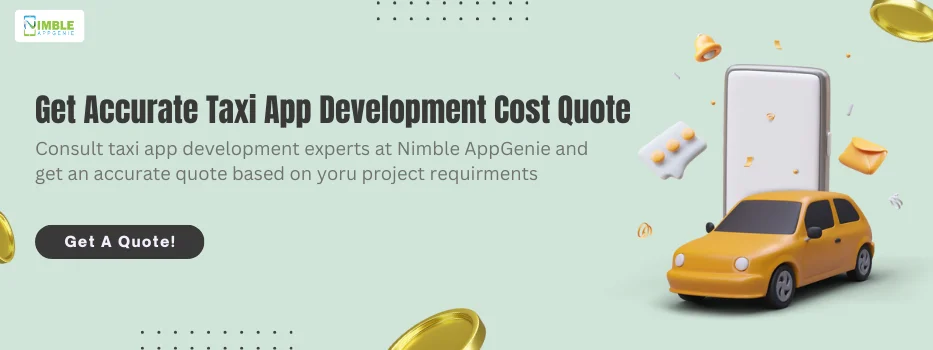
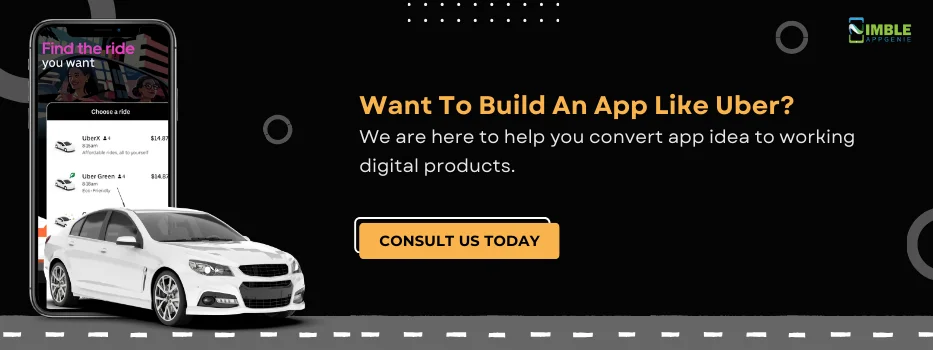
No Comments
Comments are closed.